To go straight to the prospect objection scripts, jump to this section.
For approaching clients and coaching them based on their personality, jump to this section.
To discover the 4 parts of an intuitive coaching sessions, go here.
–
So you want to become an intuitive life coach? Maybe you’re already coaching but you’re staring at your calendar wondering why clients aren’t booking sessions. The frustration is real.
This guide gives you practical strategies that work. You’ll discover how to build credibility, learn core techniques, and grow a profitable practice.
What Is Intuitive Coaching?
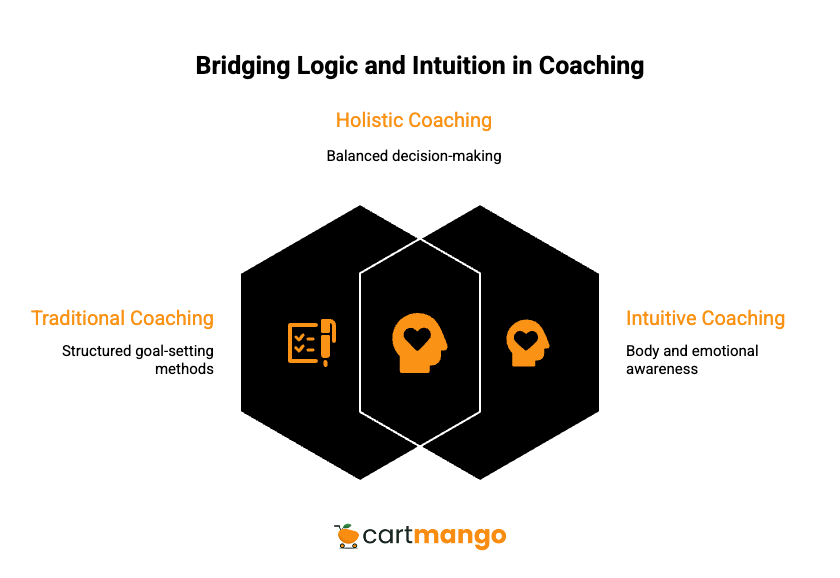
Intuitive coaching combines traditional coaching methods with your client’s inner wisdom. You help people access their gut feelings, body awareness, and unconscious insights to make better decisions.
Think of it this way:
- Your logical mind processes information step by step.
- But your intuitive mind recognizes patterns instantly.
- Intuitive coaching helps clients to trust both systems.
How does this differ from regular life coaching?
Traditional coaching relies heavily on structured questions and goal-setting frameworks. Intuitive coaching adds another layer by helping clients notice what their body and emotions are telling them.
It’s not therapy either. Therapy often explores past trauma and healing. Coaching focuses on present challenges and future goals. International Coaching Federation (ICF) Code of Ethics define these boundaries.
E.g. A business executive might logically know they should take a promotion. But their gut screams “no” every time they think about it. Intuitive coaching helps them explore that resistance and make the right choice for them.
The applications are endless. Entrepreneurs use it for strategic decisions. Parents navigate family dynamics. Career changers find their true calling. Anyone facing complex life choices benefits from this approach.
/jo
Establishing Your Authority as an Intuitive Coach
You need credibility before anyone will pay you for intuitive guidance.
This isn’t about getting fancy certificates. It’s about building trust through knowledge and results.
Start with the science. Neuroscience research shows that our brains process information unconsciously before we’re aware of it. Because of this, present-moment awareness improves coaching outcomes.
- Study the research.
- Learn how the vagus nerve affects decision-making.
- Understand mirror neurons and emotional contagion.
- When you can explain the biology behind intuition, skeptics start listening.
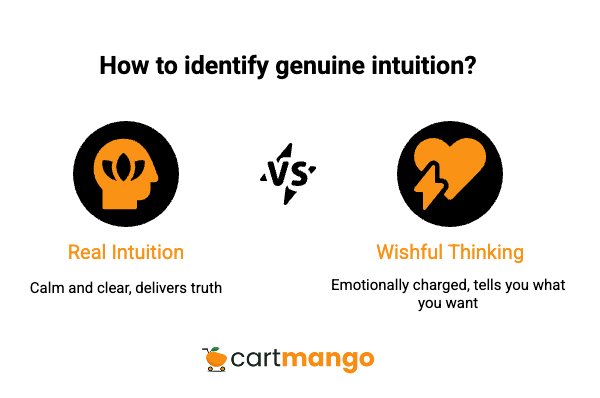
Practice distinguishing real intuitive insights from wishful thinking. Real intuition feels calm and clear, even when delivering uncomfortable truths. Wishful thinking feels emotionally charged and tells you what you want to hear.
Build your network through professional coaching certification bodies like the ICF.
Attend workshops and conferences. Connect with other coaches who take this work seriously.
Document your results obsessively. Track client outcomes and breakthrough moments.
These stories become your best marketing material. Nothing sells intuitive coaching like measurable results.
4 Parts of An Intuitive Coaching Session

1/ Minutes 1-10: Connection and Centering
You start by helping both you and your client get present. I usually begin with three deep breaths together. This isn’t woo-woo theater. It’s practical nervous system regulation.
Check in with your client’s current state. What’s happening in their body? What emotions are present? This baseline helps you notice shifts throughout the session.
–
2/ Minutes 10-40: Exploration and Insight
This is where the real work happens. You ask open-ended questions and pay attention to your client’s whole being, not just their words. Notice their breathing patterns, posture changes, and energy shifts.
When insights emerge, help your client integrate them. Ask “What does that feel like in your body?” or “If that insight had a voice, what would it tell you?”
–
3/ Minutes 40-55: Action Planning
Convert insights into concrete next steps. The most profound revelation means nothing without action. Help your client identify one or two specific commitments they can make before your next session.
–
4/ Minutes 55-60: Closing and Integration
End with a brief reflection on what emerged. Ask your client to summarize their key insights. This helps cement the learning and gives you material for follow-up.
Session Documentation Template
Client Name:
Date:
Session Number:
Session Goals:
Key Insights:
Client Emotions and Reactions:
Coach Observations:
Action Steps Agreed:
Homework/Practice Assignments:
Follow-up Date:
Additional Notes:
Core Intuitive Coaching Techniques
Now for the specific methods that make intuitive coaching work.
Master these 5 techniques and you’ll have everything you need to help clients access their inner wisdom.
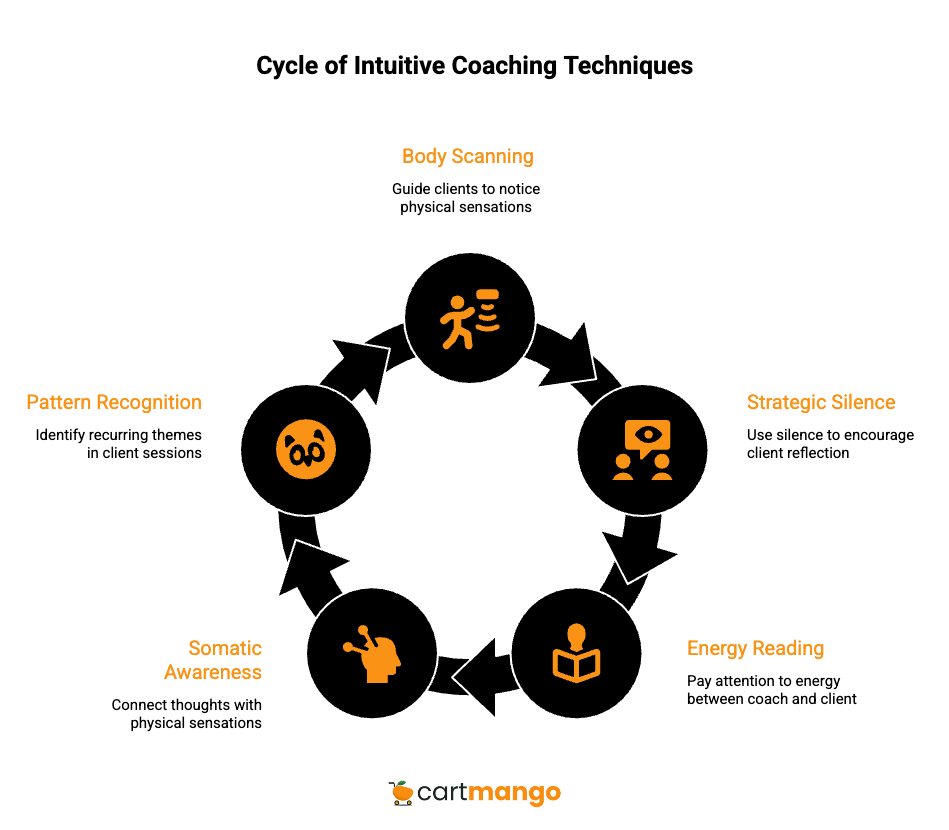
Body Scanning
Guide your client to notice physical sensations without trying to change them. Start with obvious areas like tension in shoulders or butterflies in stomach. Then explore subtler sensations.
The key is curiosity, not interpretation. “I notice my chest feels tight” is perfect. “My chest is tight because I’m scared” adds mental analysis that might not be accurate.
Strategic Silence
Most coaches talk too much. Sometimes the most powerful thing you can do is shut up and wait.
Try counting to ten after asking a question. Let your client sit with whatever emerges. That’s the power of spacious listening.
Energy Reading
Pay attention to the energy between you and your client. Does it feel heavy or light? Contracted or expansive? This isn’t mystical nonsense. You’re reading subtle cues your conscious mind hasn’t processed yet.
Trust your first impression and share it tentatively. “I’m noticing the energy in the room feels different since we started talking about your boss. Are you aware of that too?”
Somatic Awareness
Help clients notice the connection between thoughts and physical sensations. When they talk about a challenging situation, ask what they feel in their body.
This technique reveals information that purely mental processing misses. A client might say they’re excited about a new job while their body shows signs of stress.
Pattern Recognition
Listen for recurring themes across sessions. Maybe your client always feels stuck when discussing relationships but energized when talking about creative projects. Point out these patterns.
Patterns often reveal core values or limiting beliefs. When clients see their patterns clearly, they can make more conscious choices.
Pre-Session Preparation Checklist
- Review client intake form and previous session notes
- Set clear intention for the session
- Create a quiet, comfortable, and distraction-free environment
- Practice 5 minutes of mindfulness or meditation to center yourself
- Check your energy levels and practice grounding techniques
- Prepare any materials or tools needed for the session
- Ensure technology (if virtual) is working properly
- Mentally review the client’s goals and challenges
- Visualize a successful session outcome
- Take a few deep breaths to relax before starting
Problem-Solving Checklist (When Intuitive Insights Don’t Come)
- Pause and take a few deep breaths to reset your focus
- Use body awareness techniques to notice physical sensations
- Ask open-ended questions to encourage client reflection
- Shift to analytical questioning if intuition is blocked
- Incorporate mindfulness or grounding exercises
- Take a short break if needed to clear mental clutter
- Use visualization or guided imagery to stimulate insight
- Reflect on past successful intuitive moments for confidence
- Invite client to share any subtle feelings or thoughts
- Document any small insights and revisit them later
Get professional coaching training programs to develop these skills systematically. Practice with volunteers before taking paying clients. Your confidence grows with experience.
Identifying and Attracting Your Ideal Clients
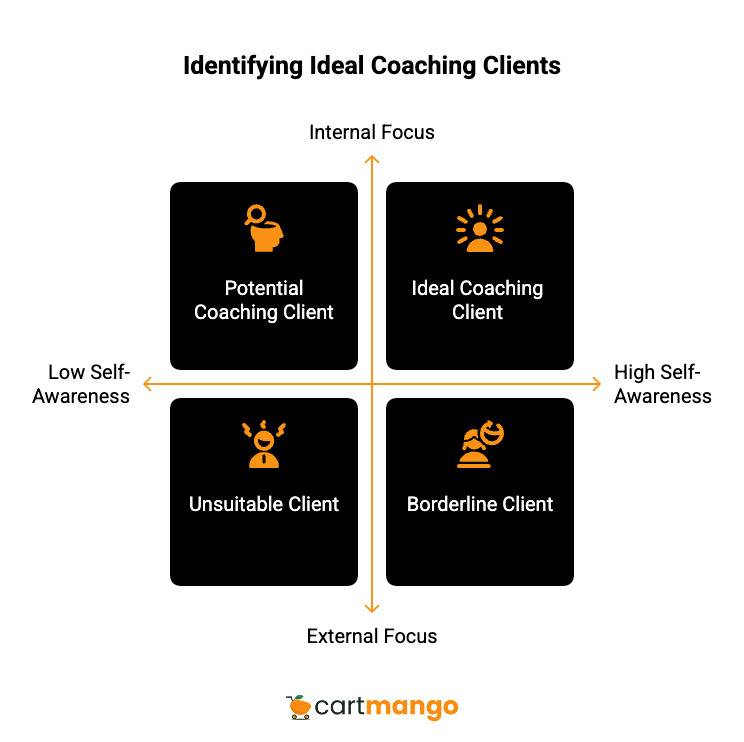
Not everyone makes a good intuitive coaching client.
- Some people need practical problem-solving.
- Others want emotional healing.
- You want clients who are ready for inner exploration.
Your ideal clients are usually going through transitions. Career changes, relationship shifts, or life purpose questions. They’ve tried logical approaches but feel stuck or disconnected from their authentic desires.
Focus on specific client types rather than trying to serve everyone. This makes your marketing clearer and your results better.
Look for clients who already show some self-awareness. They notice their emotions and pay attention to their inner experience. They don’t need you to convince them that intuition exists.
Avoid clients who want you to be their psychic. They’re looking for external answers rather than discovering their own wisdom. Also be cautious with people in crisis who might need therapy instead of coaching.
Red flags include requests for predictions about the future or resistance to taking personal responsibility. These clients often leave unsatisfied because they want magic instead of inner work.
Client Approach Based On Personality
Approach Definitions:
- Intuitive Approach: Using feelings, body awareness, and gut instincts to guide coaching
- Analytical Approach: Using logic, structured questions, and step-by-step problem-solving
- Hybrid Approach: Combining both intuitive and analytical methods in sessions
Personality Type | Intuitive Approach | Analytical Approach | Hybrid Approach |
|---|---|---|---|
Analytical | Low | High | High |
Creative | High | Medium | High |
Pragmatic | Medium | High | High |
Empathetic | High | Medium | High |
Skeptical | Low | High | Medium |
Rating Key: High = Very responsive to this approach | Medium = Somewhat responsive | Low = Less responsive
–
Niche Selection Matrix
Coaching Niche | Market Demand | Income Potential | Competition Level |
|---|---|---|---|
Entrepreneurs | High | High | High |
Corporate Leaders | High | High | Medium |
Creatives | Medium | Medium | High |
Life Transitions | High | Medium | Medium |
Health & Wellness | Medium | Medium | High |
Spiritual Seekers | Medium | Medium | Low |
Choose 1 niche to start. You can always expand later. Focus beats trying to appeal to everyone.
Marketing Your Intuitive Coaching Practice
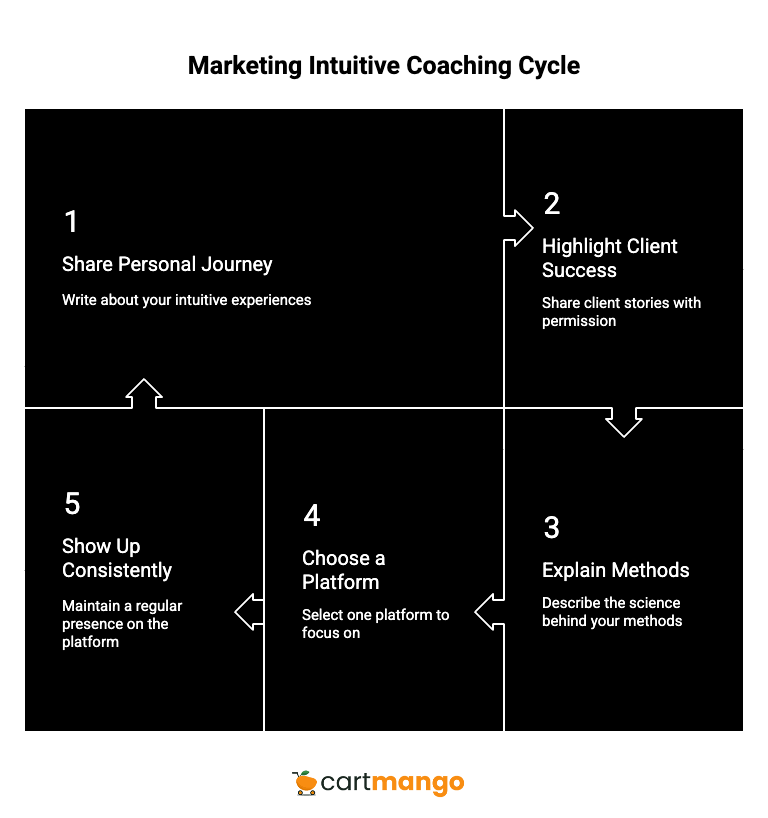
Marketing intuitive coaching feels tricky because you’re selling something intangible.
People can’t touch intuition or see it working. You need to make the invisible visible through stories and results.
Content marketing works better than traditional advertising. Write about your own intuitive journey. Share client success stories (with permission). Explain the science behind your methods.
Start with one platform and do it well.
- Maybe you love writing blogs.
- Perhaps video feels natural.
- Don’t spread yourself thin across every social media channel.
- Pick one and show up consistently.
Your biggest challenge will be skeptical prospects. They’ve been burned by coaches who promised quick fixes or acted like fortune tellers. You need scripts that address their concerns directly.
Professional networking opens more doors than online marketing alone. Join local business groups and coaching circles. Build relationships with therapists who might refer clients ready for coaching.
Price your services based on transformation, not time. A client who finds their life purpose in three sessions got tremendous value even if you only spent three hours together.
Skeptical Prospect Objection Scripts
Objection 1: “I don’t believe in intuition or this kind of coaching.”
Response: “I understand your skepticism. Intuitive coaching combines proven psychological techniques with your own inner wisdom to help you make clearer decisions and overcome blocks. It’s about enhancing your natural abilities, not replacing logic.”
–
Objection 2: “How is this different from therapy?”
Response: “Great question. Coaching focuses on your present and future goals, helping you take actionable steps, while therapy often deals with past trauma and healing. Intuitive coaching uses your inner guidance to support your growth and decision-making.”
–
Objection 3: “Is this just woo-woo nonsense?”
Response: “I get that concern. Intuitive coaching is grounded in neuroscience and mindfulness research, helping you tap into unconscious insights that your brain already processes. It’s a practical tool, not mysticism.”
–
Objection 4: “What if I don’t feel anything during sessions?”
Response: “That’s completely normal. Everyone experiences intuition differently. We can use alternative methods that suit your style, including analytical exercises and reflective practices to help you connect with your inner guidance.”
–
Objection 5: “How much does this cost?”
Response: “Pricing varies based on the program and your goals. I offer flexible packages and can help you find an option that fits your budget while delivering real value.”
–
Practice these responses until they feel natural. The worst thing you can do is get defensive when someone questions your methods.
Creating Transformational Client Experiences
Here’s what I’ve learned: every coaching engagement works great when you stop trying to fix people and start helping them remember who they really are.
Creating a safe space where clients understand they won’t be judged for their messy, complicated truth is underrated.
Clients gain trust in their own intuition when you show them their inner voice matters more than your advice. You guide clients by helping them identify patterns they’ve been blind to.
Spending time on personal development work means being fully present during coaching sessions. These become weekly lessons in human behavior that teach you as much as your clients.
Watch how clients energy shifts when they realize they already have their guidance system. They just needed the right coach to help them access it. This awareness supports their journey toward a fulfilling life built on authentic career decisions.
Beyond Traditional Coaching: The Whole Person Approach
Most coaches only work with the mind. Personal growth happens faster when you address the whole human being, not just their thoughts.
You can try including healing practices alongside traditional coaching methods. Physical healing often happens naturally when people release emotional blocks through your work together.
When clients understand their energy centers, they gain clarity about what’s been holding them back. It’s not woo-woo when it gets results.
The key is helping clients trust your intuition while developing their own. Healing modalities give them tools they can use long after your coaching relationship ends. That’s what creates lasting change.
Also… Your well being as a coach determines everything. If you’re burned out or disconnected from your own inner voice, you can’t support clients effectively. This work demands that you keep growing too.
Positive thinking isn’t about pretending everything’s fine. It’s about staying present moment by present moment, even when life gets messy. That’s how you help people build a fulfilling life that actually fits who they are.
Next Step
Building a successful intuitive life coaching practice takes time and consistent effort. But the rewards go beyond financial gain. You get to witness people reconnecting with their authentic selves daily.
- Start where you are with what you have.
- You don’t need perfect credentials or years of experience.
- Begin by practicing these techniques with friends or volunteers. Build your confidence through small successes.
If you’re already coaching, add one intuitive element to your sessions this week. Maybe start with body awareness or strategic silence. Notice what shifts for your clients when you slow down and tune in.
Join communities of like-minded coaches. Learning never stops in this field. The more you understand about human psychology and consciousness, the better coach you become.
Your clients need what you offer.
In a world of constant noise and external pressure, people crave personal guidance that helps them trust themselves. Stop doubting whether you’re qualified enough and start helping people access their own wisdom.
The techniques in this guide work when you apply them consistently. Use the templates and checklists. Use them in your practice. Adjust them based on what you learn about your unique coaching style.
Your intuitive coaching journey begins with the next person you help connect to their inner wisdom. That person might be yourself.
Related
- Sellfy vs Payhip: The Recurring Revenue Prison (2026)
- Podia vs Gumroad: The Recurring Revenue Handcuffs (2026)
- SendOwl vs Gumroad: The Recurring Revenue Black Hole (2026)
- Gumroad vs Sellfy: The Vendor Lock-in Cage (2025)
- Gumroad vs Payhip: The Hidden Trap for Creators (2025)
- ThriveCart vs SamCart – The Subscription Hostage Trap (2025)
- 8 ThriveCart Alternatives & The Lifetime Pricing Paradox (2025)
- 8 SamCart alternatives + Subscription hostage (2025)
- The GENTLE Method: Soft marketing for creators
- How Far in Advance Should You Promote a Webinar?
